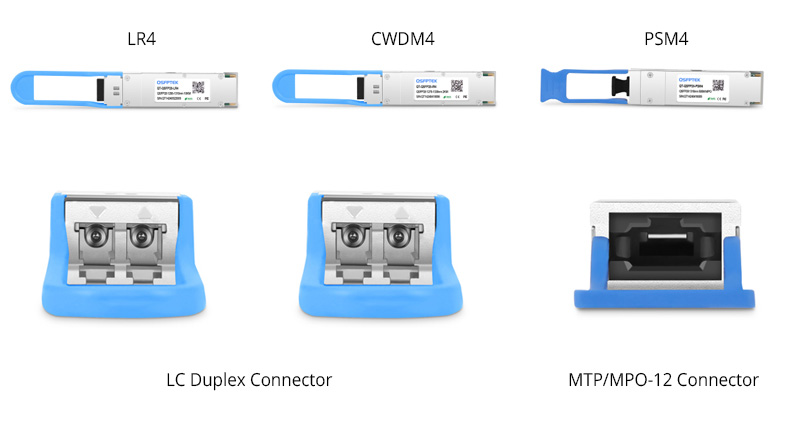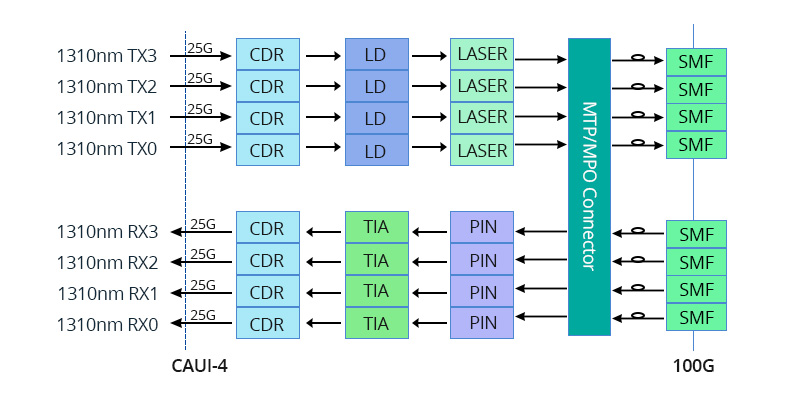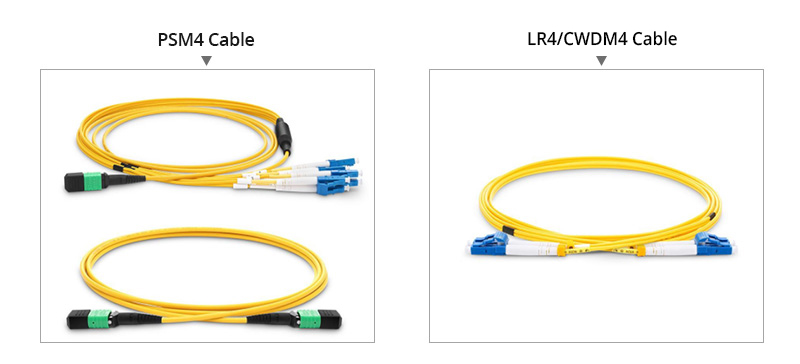QSFP28 100GBASE LR4 vs CWDM4 vs PSM4 Single-Mode DCI Solutions
Under the wave of optical communication revolution driven by 5G, 100G optical modules are becoming the core engine of data center interconnect (DCI). Faced with a variety of QSFP28 solutions - from short-distance SR4, medium-distance CWDM4/PSM4 to long-distance LR4/ER4, the three mainstream technologies in the single-mode field, CWDM4, LR4 and PSM4, have become key options for DCI deployment with their 500m~10km transmission capabilities. However, there are essential differences among the three: PSM4: 500m low-cost transmission through 4 parallel optical fibers. CWDM4: Breaking through the 2km medium-distance bottle with coarse wavelength division multiplexing. LR4: Conquering 10km metro links with precision LAN-WDM technology
How to choose the best solution? This article will deeply analyze the three decision-making dimensions of transmission distance, optical fiber architecture, and power consumption cost to help you accurately match the needs of 100G data center scenarios.

Overviews of 100G LR4 and CWDM4 and PSM4
What is 100G QSFP28 LR4 Optics?
LR4 stands for 4-channel long reach. QSFP28 LR4 100G transceiver designs for long-haul transmission distance in 100G optical interconnection. The distance of 100G LR4 can be as far as 10 kilometers over G.652 single-mode fiber with duplex LC connectors. It complies with the IEEE 802.3 100GBASE-LR4 standard.
What is 100G QSFP28 CWDM4 Optics?
CWDM4 is the abbreviation for Coarse Wavelength Division Multiplexing 4-lane. Not as far as QSFP28 LR4 transmit distance, 100G CWDM4 reaches about 2 kilometers distance over G.652 single-mode fiber with duplex LC connectors, neither too long nor too short. It adopts WDM technology, which enables the multiplexing and demultiplexing of 4 wavelengths of 25G signals within the device. It is compliant with 100GBASE-CWDM4 MSA.
What is 100G QSFP28 PSM4 Optics?
PSM4 means Parallel Single Mode Quad. The 100G QSFP28 PSM4 can reach a distance of approximately 500 meters over single-mode fiber using MTP/MPO-12 connectors. The 12 means that 100GE signals are carried over 12-fiber parallel fiber. The transmission distance is the shortest among these three transceivers, but it is still longer than the 100m transmission distance of QSFP SR4. It complies with the 100GBASE-PSM4 MSA.
100G CWDM4 vs LR4 vs PSM4 Spec Comparison
100G LR4 spec vs 100G CWDM4 spec vs 100G PSM4 Spec
Common Features of QSFP28 LR4, QSFP28 CWDM4, and QSFP28 PSM4
Supports 100G Ethernet Connectivity
Firstly, QSFP28 LR4, QSF28 CWDM4 and QSFP28 PSM4 all support 100GBase Ethernet rate. They can be applied in various 100 Gigabit Ethernet connectivity situations, such as data centers, large-scale cloud networks, high-performance computing networks, enterprise cores, and distribution layers.
Features with QSFP28 Form Factor
Secondly, they feature the QSFP28 (Quad Small Form-Factor Pluggable) form factor, which is the most compact and widely used form factor for 100G Ethernet. The development of 100G form factor has been experienced from CFP, CFP2, CFP4 to QSFP28. The size of CFP4 is only a quarter of CFP. However, QSFP28 is even smaller than CFP4. Consequently, QSFP28 features a significant advantage of higher port density. Besides high density, QSFP28 also features lower power consumption than previous available CFP form factors. The differences between QSFP28, CFP, CFP2, and CFP4 are shown in the table below.
CFP vs CFP2 vs CFP4 vs QSFP28 Form Factor
Work over Single-mode Fiber
Thirdly, 100G QSFP28 LR4, CWDM4, and PSM4 all utilize single-mode fiber to achieve distances of 10km, 2km, and 500m, respectively.
Distinct Features of 100G CWDM4 vs 100G LR4 vs 100G PSM4
The arrival of 100G CWDM4 and PSM4 filled the link distance gaps between QSFP 100G SR4 and LR4. What are the differences between CWDM4 vs LR4 vs PAM4? The below post will tell.
CWDM4 vs LR4 vs PSM4: Transmission Distance Comparison
The most significant difference between CWDM4 LR4 and PSM4 is the supported link distance. Although all three transceivers support 100G data links over single-mode fiber, the transmission distances differ: 100G CWDM4 reaches 2km, 100G PAM4 reaches 500m, and 100G LR4 reaches 10km. Although the transmission distance of PSM4 and CWDM4 is not as far as that of LR4, they provide an indispensable and cost-effective choice for 100G short-to-medium range applications.
CWDM4 vs LR4 vs PSM4: Application scenarios Comparison
PSM4 is mainly used for data center interconnection within 500 meters, especially intra-rack and inter-rack connections. CWDM4 modules are particularly suitable for connections within 2 kilometers, such as connections between different buildings on a campus. LR4 is suitable for metropolitan area network connections up to 10 kilometers and long-distance interconnection between data centers.
CWDM4 vs LR4 vs PSM4: Working Principle and Optical Component Comparison
100G CWDM4 complies with CWDM4 MSA, which defines the block diagram, specifications, and optical parameters of the transceiver. The 100G CWDM4 transceiver features four optical transmitters, four optical receivers, a wavelength division multiplexer, and a demultiplexer. It uses four-lane center wavelengths of 1271nm, 1291nm, 1311nm, and 1331nm to realize 100G optical communication, each of which transmits a 25G data rate. Based on WDM technology, the CWDM4 module enables the four-lane wavelengths multiplexing to one single-mode fiber. The working diagram is shown below.

QSFP28 100G CWDM4 Working Diagram
The working principle of 100G LR4 is similar to CWDM4; it also adopts WDM technology. The difference is that LR4 uses the four-lane wavelengths of 1295nm, 1300nm, 1304nm, and 1309nm. Besides, as QSFP28 100G operates at a long transmission link length of up to 10km, it generally uses an EML laser, while 100G CWDM4 uses a DML laser. Because EML laser is more costly than DML, here comes the below price differences between the two transceivers.

QSFP28 100G LR4 Working Diagram
Different from CWDM4 adopting WDM technology to multiplex four different wavelength lanes of signals to one single-mode fiber, 100G PSM4 carries 100G signal over four parallel lanes of 1310nm link without multiplexing and demultiplexing. Each lane supports a 25Gbps data rate. The working diagram of 100G PSM4 is shown below.

QSFP28 100G PSM4 Working Diagram
CWDM4 vs LR4 vs PSM4: Price Comparison
Typically, the price of CWDM4 is the cheapest, and LR4 is the most expensive. LR4 requires more sophisticated LAN-WDM lasers (wavelength interval is only 4.5nm), TEC (thermoelectric cooler) for temperature control, and more complex optical multiplexing/demultiplexing devices. In contrast, PSM4 uses a simpler DFB laser array and does not require wavelength control or complex multiplexing devices. It can be confirmed from the list prices from the three top 3rd-party optics manufacturers in the market as below.
CWDM4 vs LR4 vs PSM4: Price of QSFPTEK, FS, Fibermall
CWDM4 vs LR4 vs PSM4: FEC Function
As the link budgets of CWDM4 and PSM4 are relatively low, they require the application of FEC (Forward Error Correction) to ensure reliable system operation. LR4 does not employ the use of FEC due to its high link budget (about 10dB) and compliance with IEEE 802.3 100GBASE-LR4.
100G PSM4 vs 100G LR4 and CWDM4: Cable Solution
What cable does PSM4 work with? As structured with an MTP/MPO connector, the PSM4 transceiver works with MTP to MTP single-mode fiber or MTP to 4 LC single-mode fiber to connect four 25G LR transceivers in a 4x25G connectivity link. As for 100G CWDM4 and LR4, because of structuring with a duplex LC connector, they operate with duplex LC single-mode fiber in 100G links.

PSM4 Cable vs LR4/CWDM4 Cable
Summary
When planning a 100G optical network, the selection of QSFP28-100G-LR4, CWDM4 and PSM4 is essentially a triangular trade-off between distance, cost and fiber resources:
Distance requirements:
▪️ Ultra-short distance (≤500m) → PSM4 (low cost, multi-core MPO wiring required)
▪️ Medium distance (500m~2km) → CWDM4 (best cost performance, duplex LC fiber saving)
▪️ Long distance (2~10km) → LR4 (stable wavelength, reliable metropolitan-level transmission)
Fiber architecture:
▪️ Tight resources → CWDM4/LR4 (2-core LC) is preferred
▪️ High-density short distance → PSM4 (supports 4×25G splitting)
Cost sensitivity:
▪️ Budget priority → PSM4 (no WDM devices, about 5-8% lower price)
▪️ Long-distance investment → LR4 (paying a technology premium for a 10km link)
The final decision needs to be anchored to the actual link length and optical cable infrastructure, and a balance must be struck between performance and TCO (total cost of ownership) - PSM4 trades fiber core for cost, CWDM4 trades wavelength division for distance, and LR4 trades technology for span. Together, the three build a golden coverage network for 100G QSFP28 optical interconnection.
Related Article:










